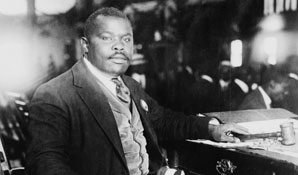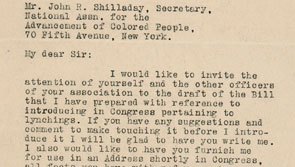
John Lewis, then leader of Student Nonviolent Coordinating Committee, rises to speak at the March on Washington in 1963. Detail ©Bob Adelman, Prints and Photographs Division
It is important to reflect upon this event in our history as we recognize and honor the 50th Anniversary of the March on Washington.
The Library of Congress has put together an extensive list of resources to remind us all of this significant event.
John Lewis was one the individuals that participated in the March and he shares his experiences in a personal narrative. At the time, John Lewis was the Leader of the Student Nonviolent Coordinating Committee. Below are some of his memories, courtesy of the Library of Congress.
You were one of the leaders of the historic March on Washington for Jobs and Freedom Aug. 28, 1963. Tell us about some of your experiences that day.

Marcus Garvey, August 5, 1924. Born in Jamaica, Marcus Garvey (1887-1940) moved to New York in 1917 to organize the American branch of the Universal Negro Improvement Association (UNIA). He also founded the Negro Factories Corporation and the Black star Steamship Line. Photograph. Prints and Photographs Division, Library of Congress (056.00.00)
[Digital ID # cph.3a03567]
After we left Capitol Hill, our plan was to link hands and lead the marchers from Capitol Hill down Constitution Avenue to the Washington Monument. We thought there might be a few thousand people, but in the end there were over 250,000. When we came out to the street, I looked towards Union Station and saw a sea of humanity marching. I said to myself, there goes our people, let me catch up to them. We linked arms and started marching with the crowd. They literally pushed us down the street, toward the memorial and onto the stage.

Congressman L.C. Dyer to John R. Shillady concerning an anti-lynching bill, April 6, 1918. Typed letter. NAACP Records, Manuscript Division, Library of Congress (047.00.00) Courtesy of the NAACP
[Digital ID # na0047]
March In Washington To Continue Focus On Civil Rights
http://www.huffingtonpost.com/2013/08/24/march-in-washington-dc_n_3808713.html
I saw this story on the BBC News iPhone App and thought you should see it:
King speech marked by BBC Radio 4
The BBC is marking the 50th anniversary of Martin Luther King’s I Have a Dream speech with a recital by notable global figures, including the Dalai Lama. Read more.
Here’s the actual feed, which is very active today as it’s the 50th anniversary of the March on Washington: https://twitter.com/todayin1963
– Jane Carlin, Library Director
